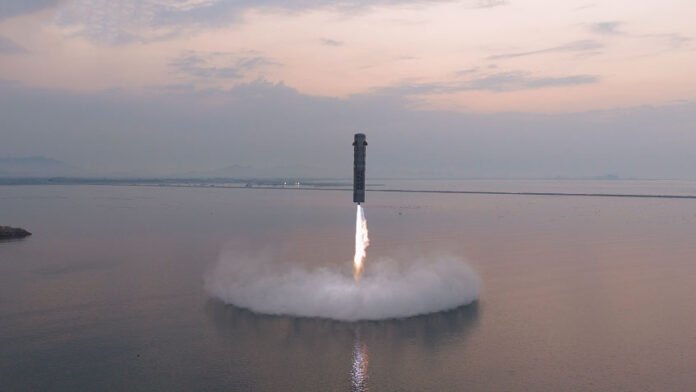By David Dickinson
June 3, 2025
Private company Space Epoch passes a crucial test, ahead of aiming for orbit later this year.
Chinese rocket startup Space Epoch put on a show recently, with a demonstration test launch of their reusable Yanxinghe-1 rocket booster.
The test launch occurred at the Oriental Spaceport commercial launch site in Shandong province, and lasted 125 seconds. The Yanxingzhe-1 rocket reached an apogee of 2.5 kilometers shortly after launch, descended, re-lit its engines and carried out an ocean soft-landing shortly after. Though the booster slowly sank into the sea after touchdown, the launch and test was a success.
The test was crucial to demonstrate full thrust, variable thrust adjustment, shutdown and restart of the engine. Free-descent, glide and hover ahead of landing was also carried out.
The rocket is an innovative design, featuring a light-weight, thin-walled aluminum stainless steel liquid oxygen and methane-fueled booster. The Yanxinghe booster used in the test is 4.2 meters in diameter and 26.8 meters tall. In contrast, SpaceX’s Falcon-9 first stage booster used in recovery landings is 3.7 meters wide, and 41 meters tall. The booster was built by the Jianyuan Technology cooperation.
 The booster launch. Credit: Space Epoch.
The booster launch. Credit: Space Epoch.
“The success of this flight recovery test is a major breakthrough in the development of liquid reusable rockets and has milestone significance.” says Sepoch and Jianyuan Technology on WeChat. “It also marks that large-scale stainless steel reusable launch vehicles have entered the engineering application stage, laying a solid foundation for this year’s first flight of Yuanxinghe No. 1.”
Space Epoch (sometimes abbreviated Sepoch) is a Bejieng-based space startup. A flurry of China-based startups have emerged in recent years, to include Landspace, iSpace and Galactic Energy. Landspace reached orbit on July 2023, and landed a booster with the test of the Zhuque-3 rocket on January 19th, 2024.
China versus SpaceX
The idea of landing and reusing boosters was pioneered by SpaceX, with the successful first landing of a Falcon-9 stage one booster on December 21st. 2015. It’s strange to think; SpaceX has turned this feat into a near daily routine occurrence, with a U.S. launch nearly every other day in 2025. Most of those have been Starlink batch launches, with 49 thus far for 2025.
 Methalox engine testing in 2021. Credit: Jiuzhou Yunjian.
Methalox engine testing in 2021. Credit: Jiuzhou Yunjian.
Watching the spaceflight schedule worldwide, launches are now mainly divided into three categories: China, SpaceX, and all others.
China’s Shanghai Spacecom Satellite Technology’s (SSST) is even currently fielding its own answer to SpaceX’s Starlink, with the company’s 1,000 Sails mega-satellite constellation initiative started in late 2024.
 A stainless steel booster tank under construction. Credit: Space Epoch.
A stainless steel booster tank under construction. Credit: Space Epoch.
Space Epoch is looking to achieve orbit with their Yuanxinghe rocket later this year. This comes as China completed the launch of its first asteroid sample retrieval mission last week, and continues a long term human presence in orbit with their Tiangong Space Station. The agency also plans to launch its own version of Hubble the Xuntian space telescope in 2026 to station-keep with Tiangong. It’s also not out of the realm of possibility that China could complete the first Mars Sample Return mission, with the launch of Tianwen-3 in 2028.
It’s a busy year in spaceflight, and it will be interesting to see Space Epoch and other China-based startups take to orbit soon.


